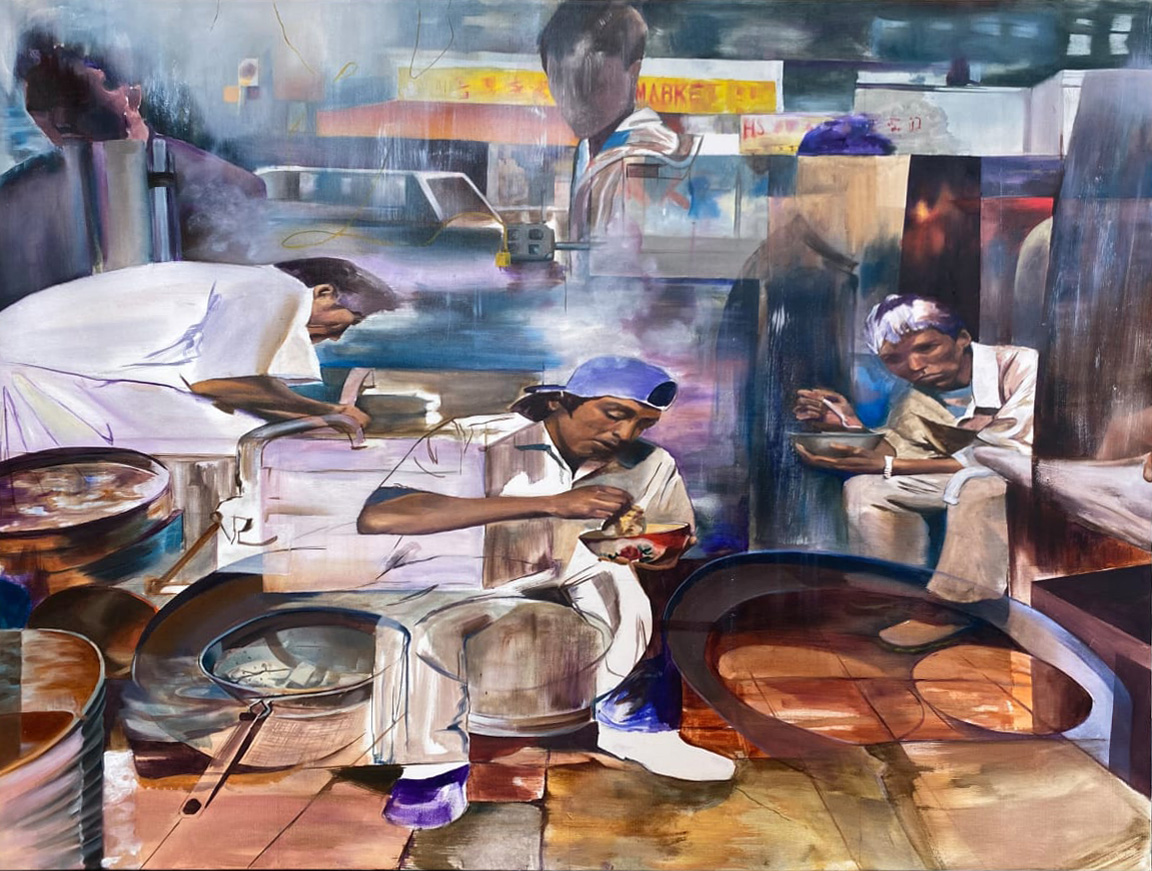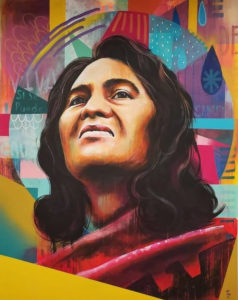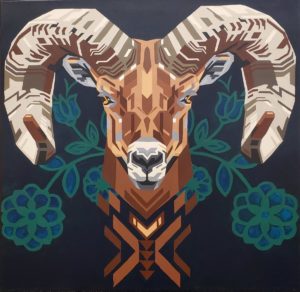
“Workers,” by Noemi Gonzalez, 2022. This piece was awarded the Jurors’ Award for Excellence in the 2022 Annual Student Exhibition in the Curfman Gallery. Gonzalez is a CSU student graduating in 2023 from the Department of Art & Art History. Noemi is interested in dealing with topics of immigration, liminal spaces, identity, and sometimes personal memories. Working from found imagery in the media to intimate family photographs that uncover a history of migration allows her to create a new narrative and to re-situate the past and present, which transcends the western notion of time. Workers is currently on display in the Lory Student Center’s Auxiliary, across from the Curfman Gallery.
With the goal of welcoming all who visit the Lory Student Center, LSC Arts is working to expand and feature its collection of artwork by artists with diverse backgrounds, especially those with marginalized identities.
“We want the LSC to be a place where all people feel welcome,” said Doug Sink, program manager for LSC Arts. “If you walk into the building and see only artwork by white people, there’s a message there. We hope to be representative of all people.”
The Representation Matters collection includes artwork from the LSC’s existing collection and newly acquired pieces, mostly purchased from students participating in the annual Student Exhibition or from artists exhibiting in one of the LSC’s main galleries. The rest have been donated by alumni or community members over the years, Sink said.

“I will usually buy work from students who have been participating in LSC Arts and who have helped develop the program. It’s a great opportunity for the students, and for us creates a wonderful connection to them,” he said.
Although art acquisition began at the LSC in 1967, a heightened focus on building a more diverse collection began in 2010, when Sink started his career at the LSC. He said that before he began, there wasn’t an organized effort to curate the collection toward any specific goal. He and his team of students set out to review the existing collection with an eye toward learning more about the diversity of contributing artists themselves.
“A collection might be more diverse than people can see,” Sink said. “We wanted to see what we knew about these artists – what they were about, who they were.”
The review revealed that the collection, accumulated over more than 50 years, was more diverse than anticipated. Still, Sink acknowledges there is still work to be done, and that it’s a slow process. New acquisitions, at the rate of two or three a year, are chosen with a focus on increasing diversity among artists within the entire collection.
Right now, of the 364 pieces of artwork in the LSC Arts collection, 97 were created by people with marginalized identities. Fifty-two of those 97 pieces are currently on the walls of the Lory Student Center, representing 43% of the 120 pieces of the larger collection now on display. With the North End Renovation nearing completion, Sink said the artwork filling the new space will be more diverse than ever.
“Moving into the north end, about half of the pieces will be part of this collection,” he said. “We are making the space more welcoming for people who might not feel welcome otherwise, while creating more cultural competency in our community.”
Students run the show
Behind the scenes, a passionate group of student employees plays a major role in the curation of artwork and management of all exhibits at the LSC. When LSC Arts does a national call for entries for exhibits in the Curfman Gallery, students select the artists and curate the shows. Students also hang artwork on walls throughout the building, manage student collections, are docents in galleries, and suggest favorite pieces for purchase.
“That level of curation you don’t find in an entry-level job,” Sink said. “It also allows them to feel it out to see if they like doing the work.”
Julia Dreisbach, a junior art major with a concentration in fibers, has been employed by LSC Arts since last semester. She said she was drawn to the position because it gives her valuable experience working in a gallery and setting up shows, activities she hopes to continue professionally after pursuing a master’s degree in art history. Dreisbach enjoys learning about the artists, their unique practices and varied backgrounds, and she’s excited to be in an environment where she can interact with people in the same sphere, she said.
“The artwork appealed to me when I came to the LSC,” Dreisbach said. “It lets people with marginalized identities know they are not alone. It’s great to come into the space and see yourself represented.”

So far, that sense of ease has been an integral part of her job at the LSC.
In helping set up a recent exhibit in the Curfman Gallery, Guardian of the Spirits, Dreisbach was able to work alongside the exhibiting artist, Holly Wong. Not only was she able to hear first-hand Wong’s ideas for presenting the exhibit, but she was also invited to offer her own.
“I got to work a lot with the artist,” Dreisbach said. “It was just so comfortable listening to her and having a conversation. I have a fibers background; she works with quilted fabrics in this show. It was great to be able to use my artistic skills.”
Collections create conversation
According to Sink, one of the best things about art is the conversations it creates.
Exhibits at the LSC’s Duhesa Gallery on Level 300, including its current exhibit, Seen Unseen by Holly Wilson, highlight the contemporary artwork of Native American artists from throughout North America who incorporate traditional methods with modern practice. Wilson uses human figures engaged in “moments of the day” as her storytellers, inviting viewers to see themselves in the experience they see. Other exhibits have featured more traditional themes.
“We have a sizeable Native American artists collection that shows a great diversity of representation,” Sink said.
The LSC’s collection of works by LGBTQIA artists is also on the rise, yet the fastest developing group within the collection is artwork by Latinx artists. LSC Arts purchased three pieces by Latinx artists last year, including contemporary paintings by Noemi Gonzalez and Armando Silva, images of which accompany this article.
Sink said he hopes the Representation Matters collection gets people thinking – and talking.
“We love to hear from folks,” he said. “If they really love the stuff on the walls, we’d love to hear about it. If it’s problematic or difficult, we want to know about that, too.
“I think we’re at an interesting time in our cultural experience, where people who have not gotten the attention or resources they need are being better recognized,” he added. “We need to be attentive to how we do that with art. Art is such a cultural mirror.”
Click here to learn about current and upcoming exhibits.